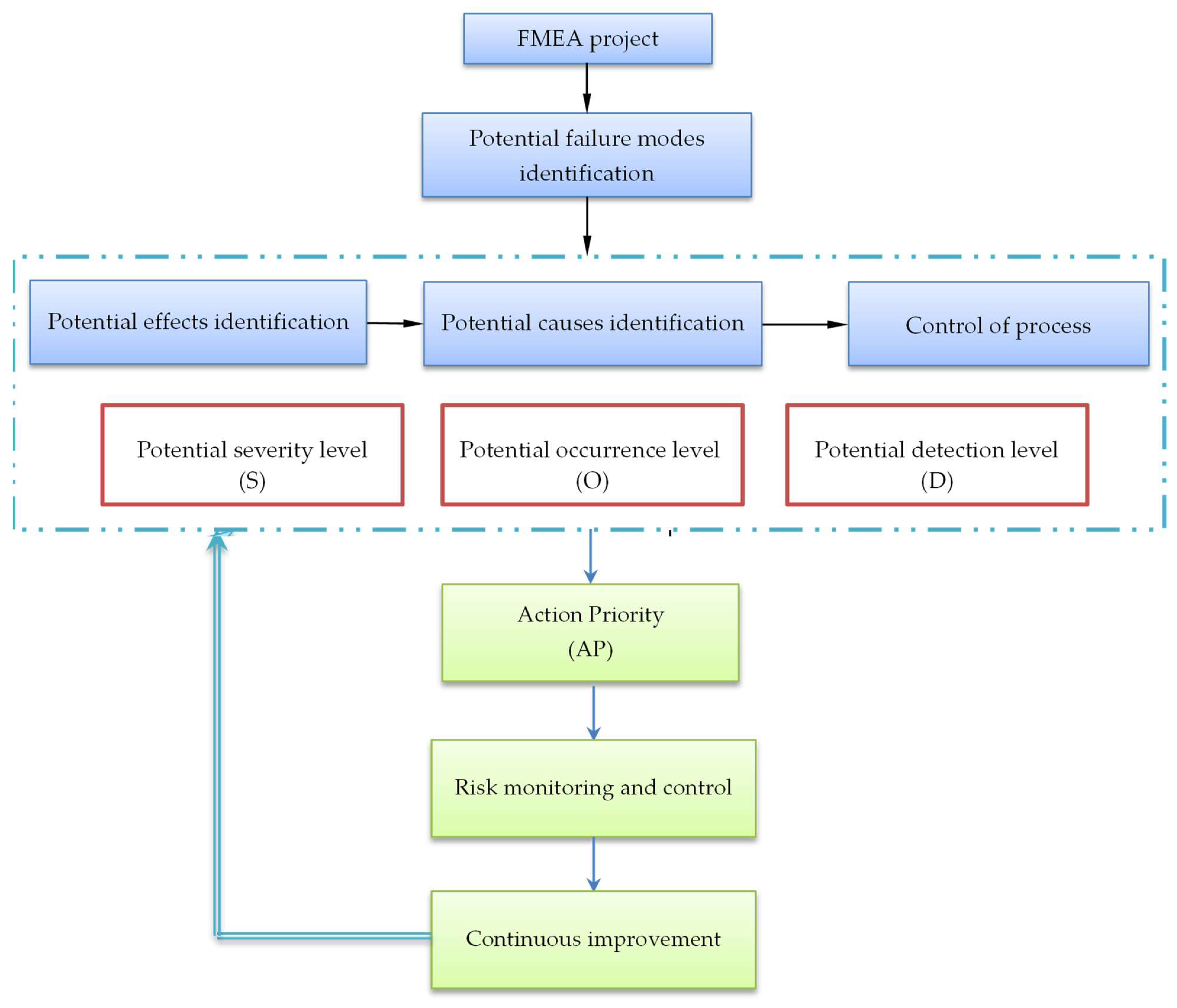Failure Modes and Effects Analysis for Automotive Trim Parts Processing †
Abstract
:1. Introduction
- FMEA is a simple method for systematically revealing the possible failures of a structure or process earlier in the design project stage. The purpose of FMEA is to reveal problems that can result in safety hazards, product malfunctions, or a shortened life. The goal is to avoid or mitigate the potential failure modes in order to prevent their occurrence [1].
- FMEA is a system reliability analysis technique used in various industries to identify, mitigate, and eliminate failure risks [2,3,4,5,6]. Considering the need to minimize or eliminate risks and meet customer expectations, an integrated quality function deployment (QFD)–FMEA framework could be useful for product and process improvement [3].
- The detailed FMEA process involves consideration of the main elements of a process, namely, people, materials, equipment, methods, measurements, and environment [1]. These key elements provide valuable information in order to identify and evaluate the failure modes as well as their potential causes and effects [4].
- Analysis of potential failure modes in the case of important safety components;
- Changes in legislation or technical conditions of the client;
- Implementation of new technology;
- Products or processes with problems related to quality and safety in their operation;
- Launching a new type of product or process;
- Changes to existing products or processes;
- Adaptation of products to new conditions of use.
- The objective of this study is to analyze the potential failure modes for the injection process of veneer trim parts. For each potential failure mode, the following are evaluated: the severity of potential effects (S), the frequency of the occurrence of potential causes (O), and the potential detection (D). These risk indices are ranked depending on action priority (AP). The purpose of implementing the failure modes and effects analysis is to control and reduce the potential causes of the potential effects and defects specific to the analyzed manufacturing process.
2. Materials and Methods
3. Results and Discussion
4. Conclusions
- The implementation of the failure modes and effects analysis can lead to a reduction in non-quality costs, a significant reduction in scraps, customer satisfaction, improvement in product quality and reliability, and fulfillment of legal requirements related to operational safety.
- The use of failure modes and effects analysis determines and ensures the efficiency and effectiveness of quality management implementation for the processing process.
- Analyzing the process from a quantitative point of view, 8.7% of defects are high risk, 78.3% medium risk, and 13% low risk. After applying corrective actions, an improvement of the process can be observed: 43.7% are low risk and 56.3% are medium risk. These results of the evaluation analysis highlight a significant improvement in the process.
- The application of the Pareto analysis allows the identification, evaluation, and ranking of the main potential failure modes, considering the cumulative relative frequency of the potential risks.
Author Contributions
Funding
Institutional Review Board Statement
Informed Consent Statement
Data Availability Statement
Acknowledgments
Conflicts of Interest
References
- Menčík, J. Concise Reliability for Engineers, Chapter 12—Failure Modes and Effects Analysis; IntechOpen: London, UK, 2016. [Google Scholar] [CrossRef]
- Du, Z.; Yu, S.; Chen, Z. Enhanced minimum-cost conflict risk mitigation-based FMEA for risk assessment in a probabilistic linguistic context. Comput. Ind. Eng. 2022, 174, 108789. [Google Scholar] [CrossRef]
- Wu, Y.; Liu, P.; Li, Y. An integrated QFD and FMEA method under the co-opetitional relationship for product upgrading. Inf. Sci. 2024, 667, 120505. [Google Scholar] [CrossRef]
- Yousef, S.; Alizadeh, A.; Hayati, J.; Baghery, M. HSE risk prioritization using robust DEA-FMEA approach with undesirable outputs: A study of automotive parts industry in Iran. Saf. Sci. 2018, 102, 144–158. [Google Scholar] [CrossRef]
- Bashir, S.; Mohammed, A.; Mujahid, A. Risk prioritization using a modified FMEA analysis in industry 4.0. J. Eng. Res. 2023, 11, 460–468. [Google Scholar] [CrossRef]
- Ervural, B.; Ayaz, I.A. A fully data-driven FMEA framework for risk assessment on manufacturing processes using a hybrid approach. Eng. Fail. Anal. 2023, 152, 107525. [Google Scholar] [CrossRef]
- Hiluf, R.; Akshay, D. Decision-making on the selection of lean tools using fuzzy QFD and FMEA approach in the manufacturing industry. Expert Syst. Appl. 2022, 192, 116416. [Google Scholar] [CrossRef]
- Failure Mode and Effects Analysis. In FMEA Handbook, 1st ed.; AIAG & VDA: Southfield, MI, USA, 2019.




Disclaimer/Publisher’s Note: The statements, opinions and data contained in all publications are solely those of the individual author(s) and contributor(s) and not of MDPI and/or the editor(s). MDPI and/or the editor(s) disclaim responsibility for any injury to people or property resulting from any ideas, methods, instructions or products referred to in the content. |
© 2024 by the authors. Licensee MDPI, Basel, Switzerland. This article is an open access article distributed under the terms and conditions of the Creative Commons Attribution (CC BY) license (https://creativecommons.org/licenses/by/4.0/).
Share and Cite
Dumitrascu, D.-I.; Dumitrascu, A.-E. Failure Modes and Effects Analysis for Automotive Trim Parts Processing. Eng. Proc. 2024, 76, 22. https://doi.org/10.3390/engproc2024076022
Dumitrascu D-I, Dumitrascu A-E. Failure Modes and Effects Analysis for Automotive Trim Parts Processing. Engineering Proceedings. 2024; 76(1):22. https://doi.org/10.3390/engproc2024076022
Chicago/Turabian StyleDumitrascu, Dorin-Ion, and Adela-Eliza Dumitrascu. 2024. "Failure Modes and Effects Analysis for Automotive Trim Parts Processing" Engineering Proceedings 76, no. 1: 22. https://doi.org/10.3390/engproc2024076022
APA StyleDumitrascu, D.-I., & Dumitrascu, A.-E. (2024). Failure Modes and Effects Analysis for Automotive Trim Parts Processing. Engineering Proceedings, 76(1), 22. https://doi.org/10.3390/engproc2024076022





